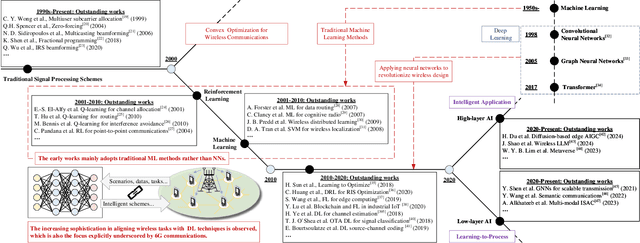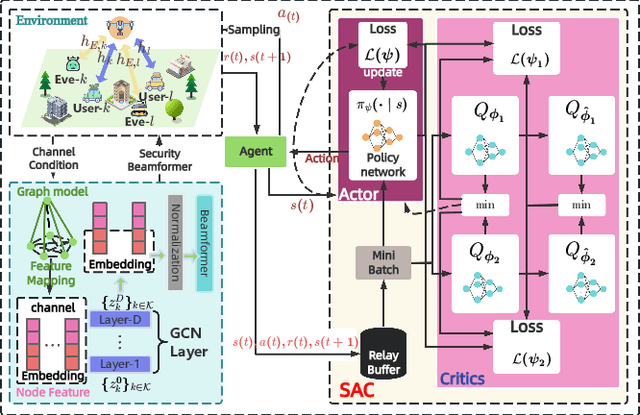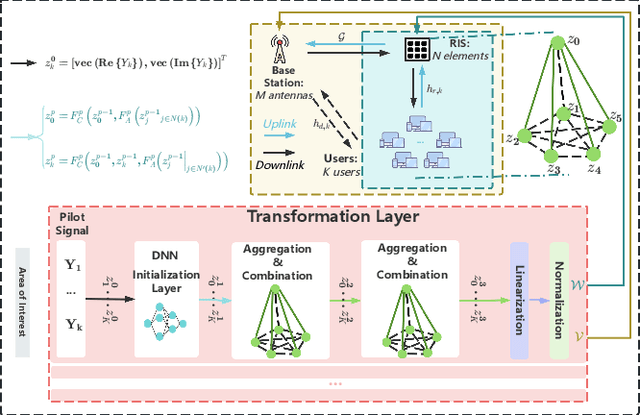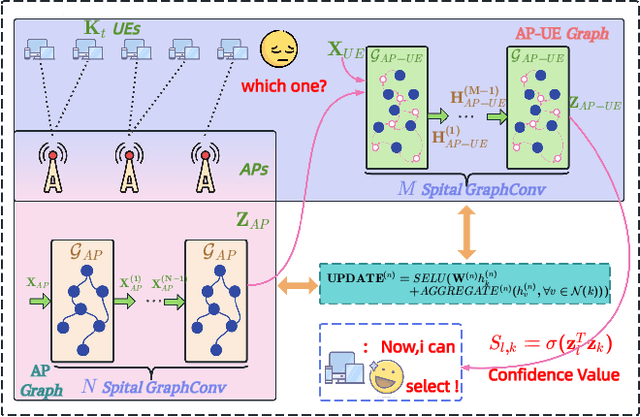Abbas Jamalipour
Sherman
Agentic Graph Neural Networks for Wireless Communications and Networking Towards Edge General Intelligence: A Survey
Aug 12, 2025



Abstract:The rapid advancement of communication technologies has driven the evolution of communication networks towards both high-dimensional resource utilization and multifunctional integration. This evolving complexity poses significant challenges in designing communication networks to satisfy the growing quality-of-service and time sensitivity of mobile applications in dynamic environments. Graph neural networks (GNNs) have emerged as fundamental deep learning (DL) models for complex communication networks. GNNs not only augment the extraction of features over network topologies but also enhance scalability and facilitate distributed computation. However, most existing GNNs follow a traditional passive learning framework, which may fail to meet the needs of increasingly diverse wireless systems. This survey proposes the employment of agentic artificial intelligence (AI) to organize and integrate GNNs, enabling scenario- and task-aware implementation towards edge general intelligence. To comprehend the full capability of GNNs, we holistically review recent applications of GNNs in wireless communications and networking. Specifically, we focus on the alignment between graph representations and network topologies, and between neural architectures and wireless tasks. We first provide an overview of GNNs based on prominent neural architectures, followed by the concept of agentic GNNs. Then, we summarize and compare GNN applications for conventional systems and emerging technologies, including physical, MAC, and network layer designs, integrated sensing and communication (ISAC), reconfigurable intelligent surface (RIS) and cell-free network architecture. We further propose a large language model (LLM) framework as an intelligent question-answering agent, leveraging this survey as a local knowledge base to enable GNN-related responses tailored to wireless communication research.
Advancing the Control of Low-Altitude Wireless Networks: Architecture, Design Principles, and Future Directions
Aug 11, 2025



Abstract:This article introduces a control-oriented low-altitude wireless network (LAWN) that integrates near-ground communications and remote estimation of the internal system state. This integration supports reliable networked control in dynamic aerial-ground environments. First, we introduce the network's modular architecture and key performance metrics. Then, we discuss core design trade-offs across the control, communication, and estimation layers. A case study illustrates closed-loop coordination under wireless constraints. Finally, we outline future directions for scalable, resilient LAWN deployments in real-time and resource-constrained scenarios.
Secure Transmission for Cell-Free Symbiotic Radio Communications with Movable Antenna: Continuous and Discrete Positioning Designs
Aug 09, 2025Abstract:In this paper, we study a movable antenna (MA) empowered secure transmission scheme for reconfigurable intelligent surface (RIS) aided cell-free symbiotic radio (SR) system. Specifically, the MAs deployed at distributed access points (APs) work collaboratively with the RIS to establish high-quality propagation links for both primary and secondary transmissions, as well as suppressing the risk of eavesdropping on confidential primary information. We consider both continuous and discrete MA position cases and maximize the secrecy rate of primary transmission under the secondary transmission constraints, respectively. For the continuous position case, we propose a two-layer iterative optimization method based on differential evolution with one-in-one representation (DEO), to find a high-quality solution with relatively moderate computational complexity. For the discrete position case, we first extend the DEO based iterative framework by introducing the mapping and determination operations to handle the characteristic of discrete MA positions. To further reduce the computational complexity, we then design an alternating optimization (AO) iterative framework to solve all variables within a single layer. In particular, we develop an efficient strategy to derive the sub-optimal solution for the discrete MA positions, superseding the DEO-based method. Numerical results validate the effectiveness of the proposed MA empowered secure transmission scheme along with its optimization algorithms.
Predictive Control over LAWN: Joint Trajectory Design and Resource Allocation
Jul 03, 2025Abstract:Low-altitude wireless networks (LAWNs) have been envisioned as flexible and transformative platforms for enabling delay-sensitive control applications in Internet of Things (IoT) systems. In this work, we investigate the real-time wireless control over a LAWN system, where an aerial drone is employed to serve multiple mobile automated guided vehicles (AGVs) via finite blocklength (FBL) transmission. Toward this end, we adopt the model predictive control (MPC) to ensure accurate trajectory tracking, while we analyze the communication reliability using the outage probability. Subsequently, we formulate an optimization problem to jointly determine control policy, transmit power allocation, and drone trajectory by accounting for the maximum travel distance and control input constraints. To address the resultant non-convex optimization problem, we first derive the closed-form expression of the outage probability under FBL transmission. Based on this, we reformulate the original problem as a quadratic programming (QP) problem, followed by developing an alternating optimization (AO) framework. Specifically, we employ the projected gradient descent (PGD) method and the successive convex approximation (SCA) technique to achieve computationally efficient sub-optimal solutions. Furthermore, we thoroughly analyze the convergence and computational complexity of the proposed algorithm. Extensive simulations and AirSim-based experiments are conducted to validate the superiority of our proposed approach compared to the baseline schemes in terms of control performance.
A Novel Indicator for Quantifying and Minimizing Information Utility Loss of Robot Teams
Jun 17, 2025Abstract:The timely exchange of information among robots within a team is vital, but it can be constrained by limited wireless capacity. The inability to deliver information promptly can result in estimation errors that impact collaborative efforts among robots. In this paper, we propose a new metric termed Loss of Information Utility (LoIU) to quantify the freshness and utility of information critical for cooperation. The metric enables robots to prioritize information transmissions within bandwidth constraints. We also propose the estimation of LoIU using belief distributions and accordingly optimize both transmission schedule and resource allocation strategy for device-to-device transmissions to minimize the time-average LoIU within a robot team. A semi-decentralized Multi-Agent Deep Deterministic Policy Gradient framework is developed, where each robot functions as an actor responsible for scheduling transmissions among its collaborators while a central critic periodically evaluates and refines the actors in response to mobility and interference. Simulations validate the effectiveness of our approach, demonstrating an enhancement of information freshness and utility by 98%, compared to alternative methods.
From Ground to Sky: Architectures, Applications, and Challenges Shaping Low-Altitude Wireless Networks
Jun 14, 2025Abstract:In this article, we introduce a novel low-altitude wireless network (LAWN), which is a reconfigurable, three-dimensional (3D) layered architecture. In particular, the LAWN integrates connectivity, sensing, control, and computing across aerial and terrestrial nodes that enable seamless operation in complex, dynamic, and mission-critical environments. In this article, we introduce a novel low-altitude wireless network (LAWN), which is a reconfigurable, three-dimensional (3D) layered architecture. Different from the conventional aerial communication systems, LAWN's distinctive feature is its tight integration of functional planes in which multiple functionalities continually reshape themselves to operate safely and efficiently in the low-altitude sky. With the LAWN, we discuss several enabling technologies, such as integrated sensing and communication (ISAC), semantic communication, and fully-actuated control systems. Finally, we identify potential applications and key cross-layer challenges. This article offers a comprehensive roadmap for future research and development in the low-altitude airspace.
Context-Aware Semantic Communication for the Wireless Networks
May 29, 2025Abstract:In next-generation wireless networks, supporting real-time applications such as augmented reality, autonomous driving, and immersive Metaverse services demands stringent constraints on bandwidth, latency, and reliability. Existing semantic communication (SemCom) approaches typically rely on static models, overlooking dynamic conditions and contextual cues vital for efficient transmission. To address these challenges, we propose CaSemCom, a context-aware SemCom framework that leverages a Large Language Model (LLM)-based gating mechanism and a Mixture of Experts (MoE) architecture to adaptively select and encode only high-impact semantic features across multiple data modalities. Our multimodal, multi-user case study demonstrates that CaSemCom significantly improves reconstructed image fidelity while reducing bandwidth usage, outperforming single-agent deep reinforcement learning (DRL) methods and traditional baselines in convergence speed, semantic accuracy, and retransmission overhead.
LAPA-based Dynamic Privacy Optimization for Wireless Federated Learning in Heterogeneous Environments
May 26, 2025Abstract:Federated Learning (FL) is a distributed machine learning paradigm based on protecting data privacy of devices, which however, can still be broken by gradient leakage attack via parameter inversion techniques. Differential privacy (DP) technology reduces the risk of private data leakage by adding artificial noise to the gradients, but detrimental to the FL utility at the same time, especially in the scenario where the data is Non-Independent Identically Distributed (Non-IID). Based on the impact of heterogeneous data on aggregation performance, this paper proposes a Lightweight Adaptive Privacy Allocation (LAPA) strategy, which assigns personalized privacy budgets to devices in each aggregation round without transmitting any additional information beyond gradients, ensuring both privacy protection and aggregation efficiency. Furthermore, the Deep Deterministic Policy Gradient (DDPG) algorithm is employed to optimize the transmission power, in order to determine the optimal timing at which the adaptively attenuated artificial noise aligns with the communication noise, enabling an effective balance between DP and system utility. Finally, a reliable aggregation strategy is designed by integrating communication quality and data distribution characteristics, which improves aggregation performance while preserving privacy. Experimental results demonstrate that the personalized noise allocation and dynamic optimization strategy based on LAPA proposed in this paper enhances convergence performance while satisfying the privacy requirements of FL.
Zero-Trust Foundation Models: A New Paradigm for Secure and Collaborative Artificial Intelligence for Internet of Things
May 26, 2025Abstract:This paper focuses on Zero-Trust Foundation Models (ZTFMs), a novel paradigm that embeds zero-trust security principles into the lifecycle of foundation models (FMs) for Internet of Things (IoT) systems. By integrating core tenets, such as continuous verification, least privilege access (LPA), data confidentiality, and behavioral analytics into the design, training, and deployment of FMs, ZTFMs can enable secure, privacy-preserving AI across distributed, heterogeneous, and potentially adversarial IoT environments. We present the first structured synthesis of ZTFMs, identifying their potential to transform conventional trust-based IoT architectures into resilient, self-defending ecosystems. Moreover, we propose a comprehensive technical framework, incorporating federated learning (FL), blockchain-based identity management, micro-segmentation, and trusted execution environments (TEEs) to support decentralized, verifiable intelligence at the network edge. In addition, we investigate emerging security threats unique to ZTFM-enabled systems and evaluate countermeasures, such as anomaly detection, adversarial training, and secure aggregation. Through this analysis, we highlight key open research challenges in terms of scalability, secure orchestration, interpretable threat attribution, and dynamic trust calibration. This survey lays a foundational roadmap for secure, intelligent, and trustworthy IoT infrastructures powered by FMs.
Temporal Spectrum Cartography in Low-Altitude Economy Networks: A Generative AI Framework with Multi-Agent Learning
May 21, 2025Abstract:This paper introduces a two-stage generative AI (GenAI) framework tailored for temporal spectrum cartography in low-altitude economy networks (LAENets). LAENets, characterized by diverse aerial devices such as UAVs, rely heavily on wireless communication technologies while facing challenges, including spectrum congestion and dynamic environmental interference. Traditional spectrum cartography methods have limitations in handling the temporal and spatial complexities inherent to these networks. Addressing these challenges, the proposed framework first employs a Reconstructive Masked Autoencoder (RecMAE) capable of accurately reconstructing spectrum maps from sparse and temporally varying sensor data using a novel dual-mask mechanism. This approach significantly enhances the precision of reconstructed radio frequency (RF) power maps. In the second stage, the Multi-agent Diffusion Policy (MADP) method integrates diffusion-based reinforcement learning to optimize the trajectories of dynamic UAV sensors. By leveraging temporal-attention encoding, this method effectively manages spatial exploration and exploitation to minimize cumulative reconstruction errors. Extensive numerical experiments validate that this integrated GenAI framework outperforms traditional interpolation methods and deep learning baselines by achieving 57.35% and 88.68% reconstruction error reduction, respectively. The proposed trajectory planner substantially improves spectrum map accuracy, reconstruction stability, and sensor deployment efficiency in dynamically evolving low-altitude environments.
 Add to Chrome
Add to Chrome Add to Firefox
Add to Firefox Add to Edge
Add to Edge